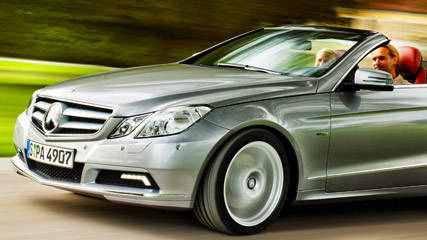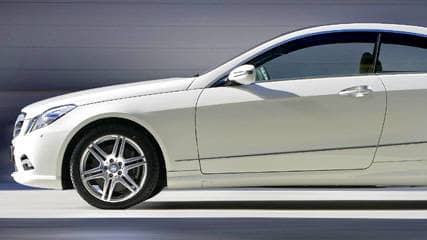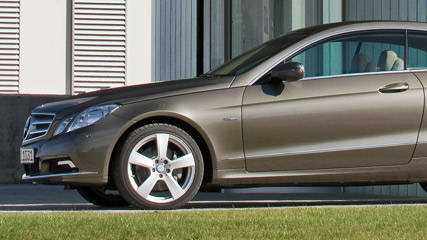Mercedes-Benz E-Class 2009 review
By Neil McDonald · 24 Jul 2009
The good folk at Sindelfingen have looked to the past to give us the future. One look at the new Mercedes-Benz E-Class sedan shows that the design team has taken some cues from the famous 1950s Pontoon models.The E-Class shares that car's bulging rear wheel arches, incorporated into the ninth-generation car's 21st century design. Apart from a passing nod to the Pontoon, the newest Merc gains a modern interpretation of the E-Class's quad headlight treatment wrapped around an entirely new body.As expected, it bristles with safety and technology. Mercedes boldly describes it as the safest car in the world.Prices have been trimmed on some models and there is more equipment across the range, while service intervals have been lifted to 25,000km.The range initially kicks off with the $128,900 E350 V6 and $178,900 E500 V8 with four other models arriving in two months. Both carry over the same engines with no change in performance. The E350 develops 200kW/350Nm while the E500 ups the ante with 285kW/530Nm.From September - two four-cylinder CDI turbo-diesels, a V6 CDI and a four cylinder CGI direction injection petrol engine join the lineup. These engines are all part of the company's Blue Efficiency technologies designed to improve aerodynamics, fuel consumption and emissions.The latest generation turbo-diesels and petrol CGI engines show just how far engine technology has come, delivering more power and torque from smaller capacity units. The 2.1-litre E220 CDI develops 125kW/400Nm, the 1.8-litre E250 CGI has 150kW/310Nm, the E250 CDI develops 150kW/500Nm and the E350 CDI develops 170kW/540Nm.The arrival of an entry level turbo-diesel is a marked departure for the brand, according to Mercedes-Benz Australia managing director, passenger cars, Horst von Sanden. It also becomes the first four-cylinder diesel E-Class to be sold here.Von Sanden says the E220 CDI reflects the growing acceptance of modern diesel technology by Australian customers. He says adding more gear into the cars was also a direct reaction to market demands. The luxury segment had become more price sensitive, he says. "We saw that with the runout of the old car," he says. "Even luxury buyers are expecting more."The entry car will be the $80,900 E220 CDI diesel four, $93,900 E250 CGI petrol four, $96,900 E 250 CDI diesel four and $131,900 E350 CDI V6. The new E350 costs $2965 less than the outgoing model, yet gets more than $10,000 in additional standard equipment. The E500 sedan is $11,232 more expensive but gets about $21,000 worth of additional standard equipment.Buyers can also specify the $5700 AMG sports pack which adds 18-inch AMG alloys, body kit, firmer suspension, sports seats, three-spoke steering wheel and brushed alloy pedals.The E350 gets front and rear parking sensors with parking guidance, 7-speed G-tronic automatic, lane keeping package with blind-spot alarm, attention assist, 18-inch alloys, bi-Xenon headlights with adaptive highbeam assist, cruise control, split/fold rear seats, cupholders, cable for the iPod input, multi-contour front seats and multi-zone climate control air-conditioning.The E500 ups the ante with keyless entry and go, more luxurious front seats, alarm and sunblinds in the rear and side rear seats.The ninth-generation sedan has grown slightly in all directions except height. At 2874mm, the wheelbase is 20mm longer, which has helped liberate more interior room. The sedan's boot capacity remains at 540-litres but it has been redesigned to improve accessibility so it can take four golfbags. Every E-Class now also gets a split fold rear seat to increase luggage room.Those looking for more punch will have to wait until November when the hotter 6.3-litre V8 E63 AMG model arrives.Mercedes has clearly improved every area of the sedan. It's stronger, quieter, beautifully finished and there is enough room and lashings of leather to please all occupants front and rear.The twin headlight front remains but the front is squarer and more upright around the familiar Mercedes grille. The overall look is mature but from some angles not as resolved as the previous generation. Time will tell how well the design will wear. At the back, the lines are more conservative with wide and bold LED tail-lights.Buyers initially have the choice of the E350 3.0-litre V6 petrol along with the E500 5.5-litre V8. Both engines carry over from the previous model. But once the newer CDI models arrive, even Mercedes admits that these powerplants have the potential to be volume sellers. With the imminent arrival of some of the impressive turbo-diesels from September, the petrol 3.0-litre V6 might just be overtaken in the performance stakes.Both the E350 and E500 have gained a bit of weight, but the benefit is added safety and a quieter car. However, with 200kW and 350Nm on tap it is a lot to ask the V6 to propel the hefty E350 1711kg sedan.On paper, Mercedes quotes a zero to 100km/h sprint of 6.3 seconds for the V6 and 5.2 seconds for the V8. On the road though both engines do not feel particularly brisk but it may have been because the cabin is so quiet that you do not get any urgency or sense of speed. Both models just go about their business without fuss.The cabin takes its cues from the S-Class and both the driver and passengers are cosetted and pampered. The ride overall in the V6 is composed, the direct control steering works well and the impressive seats set a benchmark for other brands in comfort and support.The E500 gets the lastest-generation air suspension with adaptive dampers. It delivers a plush ride on the comfort setting but feels best on the firmer setting, which adds some precision without losing ride comfort. That said, the E500 is probably best described as a luxury point-to-point tourer than an outright performance machine. It's about cocooning the occupants.There are no complaints about the seven-speed automatics in either car. Changes are slick and seamless but the V6 requires a hefty shove of the accelerator when overtaking. It is already clear that on paper at least, the 150kW/500Nm 2.1-litre E250 CDI and 170kW/540Nm V6 E350 CDI may well be the pick of the E-Class bunch.The V6 and V8 are adequate but we can't wait to drive the diesels.
.jpg)








